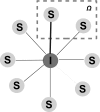Local immunization program for susceptible-infected-recovered network epidemic model
- PMID: 26931589
- PMCID: PMC7112476
- DOI: 10.1063/1.4941670
Local immunization program for susceptible-infected-recovered network epidemic model
Abstract
The immunization strategies through contact tracing on the susceptible-infected-recovered framework in social networks are modelled to evaluate the cost-effectiveness of information-based vaccination programs with particular focus on the scenario where individuals belonging to a specific set can get vaccinated due to the vaccine shortages and other economic or humanity constraints. By using the block heterogeneous mean-field approach, a series of discrete-time dynamical models is formulated and the condition for epidemic outbreaks can be established which is shown to be not only dependent on the network structure but also closely related to the immunization control parameters. Results show that increasing the immunization strength can effectively raise the epidemic threshold, which is different from the predictions obtained through the susceptible-infected-susceptible network framework, where epidemic threshold is independent of the vaccination strength. Furthermore, a significant decrease of vaccine use to control the infectious disease is observed for the local vaccination strategy, which shows the promising applications of the local immunization programs to disease control while calls for accurate local information during the process of disease outbreak.
Figures




Similar articles
-
Susceptible-infected-recovered epidemics in random networks with population awareness.Chaos. 2017 Oct;27(10):103107. doi: 10.1063/1.4994893. Chaos. 2017. PMID: 29092430
-
The impact of vaccine failure rate on epidemic dynamics in responsive networks.Chaos. 2015 Apr;25(4):043116. doi: 10.1063/1.4919245. Chaos. 2015. PMID: 25933664
-
Intermittent social distancing strategy for epidemic control.Phys Rev E Stat Nonlin Soft Matter Phys. 2012 Mar;85(3 Pt 2):036108. doi: 10.1103/PhysRevE.85.036108. Epub 2012 Mar 22. Phys Rev E Stat Nonlin Soft Matter Phys. 2012. PMID: 22587150
-
The use of mathematical models in the epidemiological study of infectious diseases and in the design of mass immunization programmes.Epidemiol Infect. 1988 Aug;101(1):1-20. doi: 10.1017/s0950268800029186. Epidemiol Infect. 1988. PMID: 3042433 Free PMC article. Review.
-
A dynamical map to describe COVID-19 epidemics.Eur Phys J Spec Top. 2022;231(5):893-904. doi: 10.1140/epjs/s11734-021-00340-5. Epub 2021 Nov 25. Eur Phys J Spec Top. 2022. PMID: 34849187 Free PMC article. Review.
References
-
- Newman M. E. J., Networks: An Introduction ( Oxford University Press, Oxford, 2010).
-
- Goldenberg J., Shavitt Y., Shir E., and Solomon S., Nat. Phys. 1, 184 (2005).10.1038/nphys177 - DOI
Publication types
MeSH terms
LinkOut - more resources
Full Text Sources
Other Literature Sources
Medical

